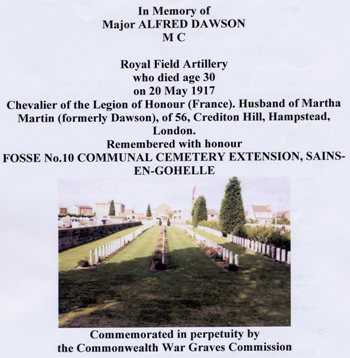|
Alfred Dawson
From the National Archives at Kew
Alfred Dawson attended preparatory school in Malvern Wells, May 1895 to July, 1900. The school was run by G E Follard, Esq., at May Place. He left there for Clifton College, Bristol, in 1900.
Army record of personal details. Next of kin, Mrs M Dawson, 67 George Street, Portman Square, London, W1 and 78 North End Road, Hampstead.
Telegram to his father, Colonel Dawson, of Etwall Hall, dated 10th October 1916. "Regret to inform you that Captain A Dawson R F A was wounded Oct 7th and admitted to Red X hospital Le Touquet Oct 8th. Gas poisoning shell wound jaw severe."
There was no corresponding telegram to his wife, Martha, in these papers.
I had been hoping to find the specific action for which Alfred was awarded the Military Cross, but that was not to be. However, the citation was for "Distinguished service in the field" and was announced in the London Gazette on the first of January 1917. "His Majesty the King has been graciously pleased to approve of the under mentioned awards for distinguished service in the field," dated 1 Jan 1917. There were many names in the long list, not all of them military. It was, in fact, the New Year's Honours List.
When Alfred was killed in May 1917, Martha applied for a pension, but there was no more correspondence about that. However, there was an appeal for money from Alfred's groom, Bombardier Frazer, who wrote to say that he had not been paid since the war started. Colonel Dawson, of Etwall Hall, Alfred's father, sent the solicitors a cheque for £50, to pay his son's debt to his groom.
The saddest remittance of all was the following package of effects of the deceased to his pregnant young widow. "2 tobacco pouches, 1 match box cover, 2 wrist watches, (one damaged), 1 cigarette case, 1 photo in leather case, 1 pipe (damaged) 1 treasury note case, 1 leather belt, 1 small note book, letters, one whistle, I cheque book, 2 pencils, 1 handkerchief."
Derby Daily Telegraph, May 30th 1917
Major Dawson killed
Passing out of Woolwich into the Royal Field Artillery in 1906, the deceased had gained his Captaincy in October, 1914, in which month he was mentioned by Lord French in dispatches and had the knighthood of the Legion of Honour conferred on him by the French President. Further promotion came in November last, followed by the award of the Military Cross.
l
 From the MAGIC ATTIC, Swadlincote. Burton Mail From the MAGIC ATTIC, Swadlincote. Burton Mail
Major Dawson, M C killed
Major A Dawson, Royal Field Artillery, Chevalier de la Legion d'honour, M C was killed in action on May 20th. He was the only son of Lieutenant Colonel and Mrs M S Dawson, of Etwall Hall. He was 30 years of age, and passed out of Woolwich into the Royal Artillery in December, 1905
He had his Captaincy in 0ctober 1914, and his Majority in November, last year.
Major Dawson served with great distinction in the War. He was mentioned in dispatches from Viscount French in October, 1914, and the French President conferred on him the knighthood of the Legion of Honour. His award of the Military Cross was in last year's Honours List. Recorded in the Times list of Military Crosses, January the first, 1917.
IN MEMORIAM.
From the Times Friday May 20th 1921
"DAWSON In memory of Major A Dawson, M C Chevalier de la Legion d' Honneur, RFA. Killed in action 2nd May, 1917. Also in honorable memory of this gallant men who fell with him."
His father, Colonel Mathew Smith Dawson, served in the South African War 1900-1902, with the Imperial Yeomanry, was an honorary major in the Army in 1902, Major in command of the Notts (Sherwood Rangers) Yeomanry from 1904 to 1913. He was Lieutenant-Colonel (temporary) in 1914, was Lieutenant-Colonel Res. Officers (Brevet Colonel) in 1917, the year his son was killed. He came from an illustrious military family.
|